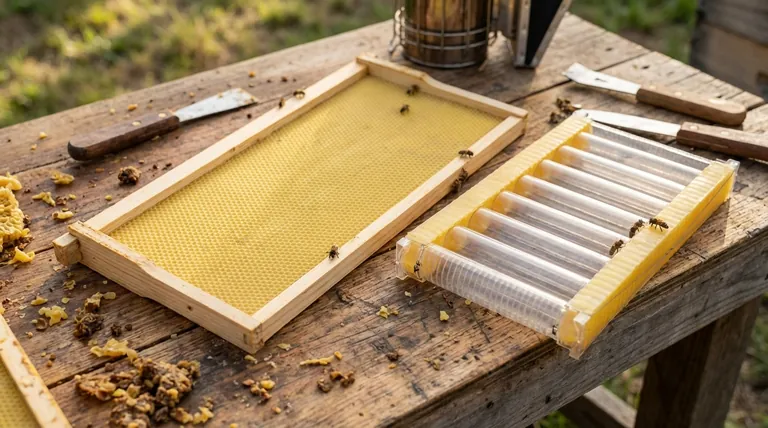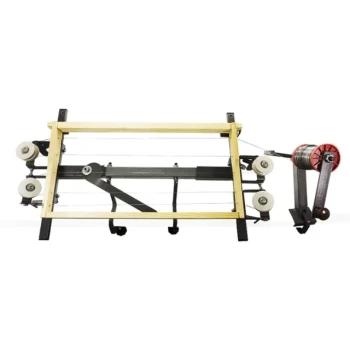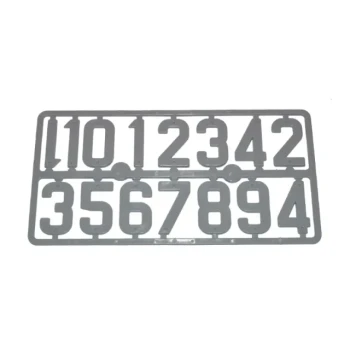In simple terms, the frame is the rigid rectangular structure, while the foundation is the thin sheet placed inside it. The frame provides the overall support, and the foundation gives the bees a patterned guide to build their wax honeycomb neatly and efficiently.
The core distinction is one of function: the frame is the skeleton that allows for organization and removal, while the foundation is the blueprint that guides the bees' construction.

The Role of Each Component
Understanding how frames and foundation work together is fundamental to modern beekeeping. This system is what allows beekeepers to manage a colony without destroying the bees' hard work.
The Frame: Providing Structure
A frame is the wooden or plastic rectangle that hangs inside the hive body. Its primary purpose is to hold the honeycomb.
This design allows each section of comb to be lifted out individually. This makes hive inspections, disease checks, and honey harvesting possible with minimal disruption to the colony.
The Foundation: Providing a Guide
Foundation is a sheet, typically made of beeswax or plastic, that is imprinted with the hexagonal shape of honeycomb cells. It is installed directly inside the frame.
This pattern acts as a starter for the bees. It encourages them to build straight, uniform comb, which prevents a tangled mess and makes the frames easy to remove and manage. It also saves the bees significant time and energy, as they don't have to produce as much wax from scratch.
How They Work Together
Think of it like building a house. The frame is the plot of land and the structural beams, defining the space. The foundation is the architectural blueprint laid on the ground, showing exactly where the walls should go.
The bees then act as the construction crew, building their wax comb directly on top of the guided pattern provided by the foundation, all within the structure of the frame.
Key Options and Their Trade-offs
Beekeepers have several choices when it comes to frames and foundation, each with distinct advantages and disadvantages. Your choice often comes down to convenience versus a more traditional approach.
All-in-One Plastic Frames
These units combine the frame and foundation into a single piece of durable, food-grade plastic. They often come pre-coated with a thin layer of beeswax.
Their main advantage is convenience. They are ready to use immediately, require no assembly, and are very durable. However, some beekeepers find that bees can be slower to build on plastic compared to pure beeswax.
Wood Frames with Separate Foundation
This is the more traditional method. Beekeepers purchase wooden frame components and assemble them, then separately install a sheet of either beeswax or plastic foundation.
This approach offers flexibility. It allows you to choose your preferred foundation type and is often seen as a more "natural" option, especially when using pure beeswax foundation. The primary downside is the time required for assembly.
Foundationless Beekeeping
Some beekeepers choose to use frames with only a small starter strip of wood or wax along the top bar. This is known as foundationless beekeeping.
This encourages bees to build their comb with natural cell sizes. However, it requires more careful management, as bees may build irregular "cross comb" that connects multiple frames, making inspections difficult.
Making the Right Choice for Your Goal
Selecting the right system depends entirely on your beekeeping philosophy and how much time you want to invest in equipment preparation.
- If your primary focus is simplicity and getting started quickly: Choose all-in-one plastic frames or fully assembled wood frames with pre-installed foundation.
- If your primary focus is a traditional or more natural setup: Use unassembled wood frames and install pure beeswax foundation yourself.
- If you are an experienced beekeeper focused on natural comb: You might explore foundationless frames, but be prepared for more intensive hive management.
Ultimately, both frames and foundation are tools designed to create a productive partnership between the beekeeper and the bees.
Summary Table:
| Component | Primary Function | Common Materials | Key Advantage |
|---|---|---|---|
| Frame | Provides structural support and allows for easy comb removal. | Wood, Plastic | Enables hive inspections and honey harvesting. |
| Foundation | Acts as a guide for bees to build straight, uniform comb. | Beeswax, Plastic | Saves bees time and energy; prevents messy cross-comb. |
Ready to Equip Your Apiary with the Right Foundation?
Choosing the correct frames and foundation is critical for a productive and manageable hive. HONESTBEE supplies high-quality, durable beekeeping supplies and equipment to commercial apiaries and beekeeping equipment distributors through our wholesale-focused operations. We can help you select the best setup—from convenient all-in-one plastic frames to traditional wood and wax options—to maximize your colony's health and honey production.
Contact HONESTBEE today for wholesale pricing and expert advice tailored to your commercial beekeeping needs.
Visual Guide

Related Products
- 7 x Auto Bee Flow Hive Frames Plastic Beekeeping Hive Box Supplies
- Automatic Honey Flow Beehive 4 Frame Mini Hive for Beekeeping
- Wholesales Dadant Size Wooden Bee Hives for Beekeeping
- Professional Frame Comb Fork and Lifter for Efficient Handling
- HONESTBEE Advanced Ergonomic Stainless Steel Hive Tool for Beekeeping
People Also Ask
- How do you clean plastic frames? A Gentle Guide to Preserving Your Frames
- What is the role of oxalic acid in plants? A Key to Plant Defense and Internal Regulation
- What do bees do after the comb is reset in Flow Frames? Maximize Your Hive's Honey Production Efficiency
- What is the selling point of the Flow Hive? A Revolutionary, Stress-Free Honey Harvest
- What are the advantages of using an Auto Flow Hive? Experience Gentle, On-Tap Honey Harvesting



















